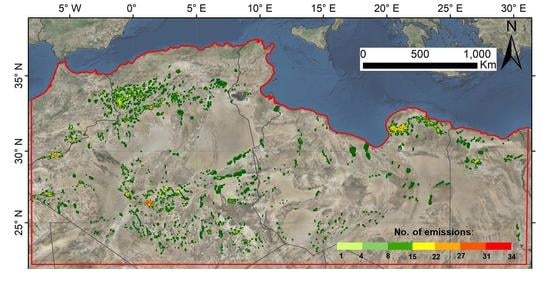Areal Extent of Dust Emission Events and Source Geomorphology in Northern Africa from MSG-SEVIRI Data
Abstract
:1. Introduction
2. Study Area and Methods
- The Land Surface Map (LSM), made available in raster form by Parajuli and Zender [27]. The LSM was originally developed by visually mapping the Middle East and North Africa regions according to land cover classes with high resolution Google Earth Pro images [28]. These polygons were used as training samples for a global supervised classification (500 m pixel) that used the maximum likelihood method applied to the global Blue Marble (MODIS RGB) image mosaic [27].
- The soil map of the Harmonized World Soil Database (HWSD) [29]. This digital, GIS-based soil map (1 km spatial resolution) was compiled from global and regional soil maps, originally at scales of 1:1,000,000 to 1:5,000,000, and it holds information on the dominant soil type or geomorphic unit of each mapping unit. Following Crouvi et al. [5], we used several soil types as proxies for geomorphic units, for example, solonetz and solonchaks are usually playa or sabkha soils, rich in soluble salts and clays; arenosols are quartz-rich sandy soils [30].
- A combined map of the LSM and HWSD datasets mentioned above (defined here as “LSM-HWSD”). We found that both datasets either over- or under-estimate specific mapping units in northern Africa. Through a detailed comparison of these maps with visual interpretation of Google Earth images in specific regions, we found that: (a) The LSM overestimate sand dunes coverage comparing the HWSD (42% vs. 17%, respectively). This overestimation is partly related to the absence of a loess deposits category in the LSM [27], in which these sediments are probably partly classified as sand dunes. (b) Playa units (defined in the LSM as “Playa/Sabkha” unit, and in the HWSD as solonetz, solonchaks, salt flats and gypsisols) generally cover similar percentage for the two datasets, with slightly greater coverage for the HWSD comparing the LSM (4.5% vs. 4.2%, respectively); however, these areas do not fully overlap—visual inspection revealed that many small playas were not identified correctly by the LSM as opposed to the HWSD. c) The HWSD underestimates fluvial systems compared to the LSM (defined as “fluvial system” in the LSM, and as “Fluvisols” in the HWSD, coverage of 2.0% vs. 3.5%, respectively). Thus, to compensate for these three identified inaccuracies, we copied the units that represent playas and fluvial systems from the HWSD and pasted them into the LSM, keeping all other polygons of the LSM unchanged. The combined databases (LSM-HWSD) resulted in a more realistic representation of the geomorphic units considered herein (sand dunes 39.0%, playa units 8.0%, fluvial systems 6.0%) (Table S1, Supplementary Material). Thus, in this paper we assume that the LSM-HWSD is an improved version of the LSM.
3. Results
3.1. Qualitative Analysis of the Geomorphic Units in Hotspots
3.2. Quantitative Analysis of All Dust Emitting Areas
4. Discussion
4.1. Scattered Dust Sources Versus Hot Spots
4.2. Area of Dust Emission Events
4.3. Source Identification Offsets
4.4. Dust Source Geomorphology—Quantitative Estimation
5. Conclusions
Supplementary Materials
Author Contributions
Funding
Acknowledgments
Conflicts of Interest
References
- Gillette, D.A. A qualitative geophysical explanation for hot spot dust emitting source regions. Contrib. Atmos. Phys. 1999, 72, 67–77. [Google Scholar]
- Harrison, S.P.; Kohfeld, K.E.; Roelandt, C.; Claquin, T. The role of dust in climate changes today, at the last glacial maximum and in the future. Earth Sci. Rev. 2001, 54, 43–80. [Google Scholar] [CrossRef]
- Mahowald, N.; Ballantine, J.; Feddema, J.; Ramankutty, N. Global trends in visibility: Implications for dust sources. Atmos. Chem. Phys. 2007, 7, 3309–3339. [Google Scholar] [CrossRef] [Green Version]
- Shao, Y.; Wyrwoll, K.-H.; Chappell, A.; Huang, J.; Lin, Z.; McTainsh, G.H.; Mikami, M.; Tanaka, T.Y.; Wang, X.; Yoon, S. Dust cycle: An emerging core theme in Earth system science. Aeolian Res. 2011, 2, 181–204. [Google Scholar] [CrossRef]
- Crouvi, O.; Schepanski, K.; Amit, R.; Gillespie, A.R.; Enzel, Y. Multiple dust sources in the Sahara Desert: The importance of sand dunes. Geophys. Res. Lett. 2012, 39, L13401. [Google Scholar] [CrossRef]
- Webb, N.P.; McGowan, H.A. Approaches to modelling land erodibility by wind. Prog. Phys. Geogr. 2009, 33, 587–613. [Google Scholar] [CrossRef]
- Ginoux, P.; Prospero, J.M.; Gill, T.E.; Hsu, N.C.; Zhao, M. Global-scale attribution of anthropogenic and natural dust sources and their emission rates based on MODIS Deep Blue aerosol products. Rev. Geophys. 2012, 50. [Google Scholar] [CrossRef]
- Okin, G.S.; Bullard, J.E.; Reynolds, R.L.; Ballantine, J.A.C.; Schepanski, K.; Todd, M.C.; Belnap, J.; Baddock, M.C.; Gill, T.E.; Miller, M.E. Dust: Small-scale processes with global consequences. EosTrans. Am. Geophys. Union 2011, 92, 241–242. [Google Scholar] [CrossRef]
- Bullard, J. Bridging the gap between field data and global models: Current strategies in aeolian research. Earth Surf. Process. Landf. 2010, 35, 496–499. [Google Scholar] [CrossRef] [Green Version]
- Bullard, J.E.; Harrison, S.P.; Baddock, M.C.; Drake, N.; Gill, T.E.; McTainsh, G.; Sun, Y. Preferential dust sources: A geomorphological classification designed for use in global dust–cycle models. J. Geophys. Res. Atmos. 2011, 116, 4034. [Google Scholar] [CrossRef] [Green Version]
- Engelstaedter, S.; Tegen, I.; Washington, R. North African dust emissions and transport. Earth Sci. Rev. 2006, 79, 73–100. [Google Scholar] [CrossRef]
- Huneeus, N.; Schulz, M.; Balkanski, Y.; Griesfeller, J.; Prospero, J.; Kinne, S.; Bauer, S.; Boucher, O.; Chin, M.; Dentener, F. Global dust model intercomparison in AeroCom phase I. Atmos. Chem. Phys. 2011, 11, 7781–7816. [Google Scholar] [CrossRef] [Green Version]
- Tanaka, T.Y.; Chiba, M. A numerical study of the contributions of dust source regions to the global dust budget. Glob. Planet. Chang. 2006, 52, 88–104. [Google Scholar] [CrossRef]
- Tegen, I.; Hollrig, P.; Chin, M.; Fung, I.; Jacob, D.; Penner, J. Contribution of different aerosol species to the global aerosol extinction optical thickness: Estimates from model results. J. Geophys. Res. 1997, 102, 23895–23915. [Google Scholar] [CrossRef]
- Prospero, J.M.; Ginoux, P.; Torres, O.; Nicholson, S.E.; Gill, T.E. Environmental characterization of global sources of atmospheric soil dust identified with the Nimbus 7 Total Ozone Mapping Spectrometer (TOMS) absorbing aerosol product. Rev. Geophys. 2002, 40, 1002. [Google Scholar] [CrossRef]
- Washington, R.; Todd, M.; Middleton, N.J.; Goudie, A. Dust-storm source areas determined by the Total Ozone Monitoring Spectrometer and surface observations. Ann. Assoc. Am. Geogr. 2003, 93, 297–313. [Google Scholar] [CrossRef]
- Schepanski, K.; Tegen, I.; Laurent, B.; Heinold, B.; Macke, A. A new Saharan dust source activation frequency map derived from MSG-SEVIRI IR-channels. Geophys. Res. Lett. 2007, 34, L18803. [Google Scholar] [CrossRef] [Green Version]
- Schepanski, K.; Tegen, I.; Macke, A. Saharan dust transport and deposition towards the tropical northern Atlantic. Atmos. Chem. Phys. 2009, 9, 1173–1189. [Google Scholar] [CrossRef] [Green Version]
- Baddock, M.C.; Bullard, J.E.; Bryant, R.G. Dust source identification using MODIS: A comparison of techniques applied to the Lake Eyre Basin, Australia. Remote Sens. Environ. 2009, 113, 1511–1528. [Google Scholar] [CrossRef] [Green Version]
- Vickery, K.J.; Eckardt, F.D.; Bryant, R.G. A sub-basin scale dust plume source frequency inventory for southern Africa, 2005–2008. Geophys. Res. Lett. 2013, 40, 5274–5279. [Google Scholar] [CrossRef] [Green Version]
- Ashpole, I.; Washington, R. A new high-resolution central and western Saharan summer time dust source map from automated satellite dust plume tracking. J. Geophys. Res. Atmos. 2013, 118, 6981–6995. [Google Scholar] [CrossRef]
- Ballantine, J.A.; Okin, G.S.; Prentiss, D.E.; Roberts, D.A. Mapping North African landforms using continental scale unmixing of MODIS imagery. Remote Sens. Environ. 2005, 97, 470–483. [Google Scholar] [CrossRef]
- Eumetsat. Available online: http://oiswww.eumetsat.org/WEBOPS/msginterpretation/index.html (accessed on 28 July 2020).
- Ackerman, S.A. Remote sensing aerosols using satellite infrared observations. J. Geophys. Res. Atmos. 1997, 102, 17069–17079. [Google Scholar] [CrossRef]
- Sokolik, I.N. The spectral radiative signature of wind-blown mineral dust: Implications for remote sensing in the thermal IR region. Geophys. Res. Lett. 2002, 29, 7-1–7-4. [Google Scholar] [CrossRef] [Green Version]
- Lensky, I.; Rosenfeld, D. Clouds-aerosols-precipitation satellite analysis tool (CAPSAT). Atmos. Chem. Phys. 2008, 8, 6739–6753. [Google Scholar] [CrossRef] [Green Version]
- Parajuli, S.P.; Zender, C.S. Connecting geomorphology to dust emission through high-resolution mapping of global land cover and sediment supply. Aeolian Res. 2017, 27, 47–65. [Google Scholar] [CrossRef]
- Parajuli, S.P.; Yang, Z.-L.; Kocurek, G. Mapping erodibility in dust source regions based on geomorphology, meteorology, and remote sensing. J. Geophys. Res. 2014, 119, 1977–1994. [Google Scholar] [CrossRef]
- Baddock, M.C.; Ginoux, P.; Bullard, J.E.; Gill, T.E. Do MODIS-defined dust sources have a geomorphological signature? Geophys. Res. Lett. 2016, 43, 2606–2613. [Google Scholar] [CrossRef] [Green Version]
- FAO. Available online: http://www.fao.org/soils-portal/soil-survey/soil-maps-and-databases/faounesco-soil-map-of-the-world/en/ (accessed on 28 July 2020).
- Brindley, H.; Knippertz, P.; Ryder, C.; Ashpole, I. A critical evaluation of the ability of the Spinning Enhanced Visible and Infrared Imager (SEVIRI) thermal infrared red-green-blue rendering to identify dust events: Theoretical analysis. J. Geophys. Res. Atmos. 2012, 117. [Google Scholar] [CrossRef] [Green Version]
- Banks, J.R.; Hünerbein, A.; Heinold, B.; Brindley, H.E.; Deneke, H.; Schepanski, K. The sensitivity of the colour of dust in MSG-SEVIRI Desert Dust infrared composite imagery to surface and atmospheric conditions. Atmos. Chem. Phys. 2019, 19, 6893–6911. [Google Scholar] [CrossRef] [Green Version]
- Bullard, J.E.; McTainsh, G.H.; Pudmenzky, C. Aeolian abrasion and modes of fine particle production from natural red dune sands: An experimental study. Sedimentology 2004, 51, 1103–1125. [Google Scholar] [CrossRef]
- Swet, N.; Elperin, T.; Kok, J.F.; Martin, R.L.; Yizhaq, H.; Katra, I. Can active sands generate dust particles by wind-induced processes? Earth Planet. Sci. Lett. 2019, 506, 371–380. [Google Scholar] [CrossRef] [Green Version]
- Crouvi, O.; Amit, R.; Enzel, Y.; Gillespie, A.R. The role of active sand seas in the formation of desert loess. Quat. Sci. Rev. 2010, 29, 2087–2098. [Google Scholar] [CrossRef]
- Feuerstein, S.; Schepanski, K. Identification of Dust Sources in a Saharan Dust Hot-Spot and Their Implementation in a Dust-Emission Model. Remote Sens. 2019, 11, 4. [Google Scholar] [CrossRef] [Green Version]
- Gherboudj, I.; Beegum, S.N.; Ghedira, H. Identifying natural dust source regions over the Middle-East and North-Africa: Estimation of dust emission potential. Earth Sci. Rev. 2017, 165, 342–355. [Google Scholar] [CrossRef]
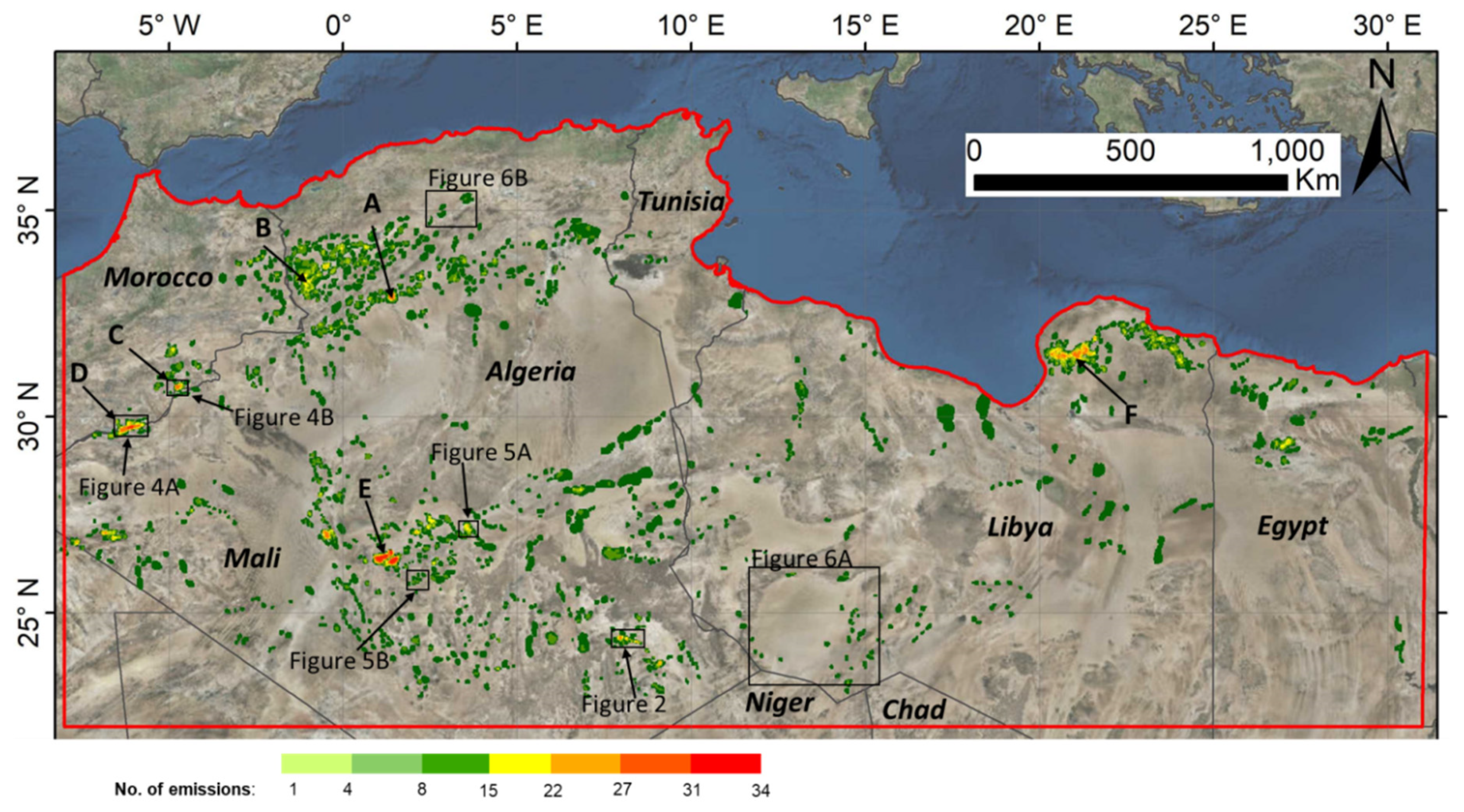

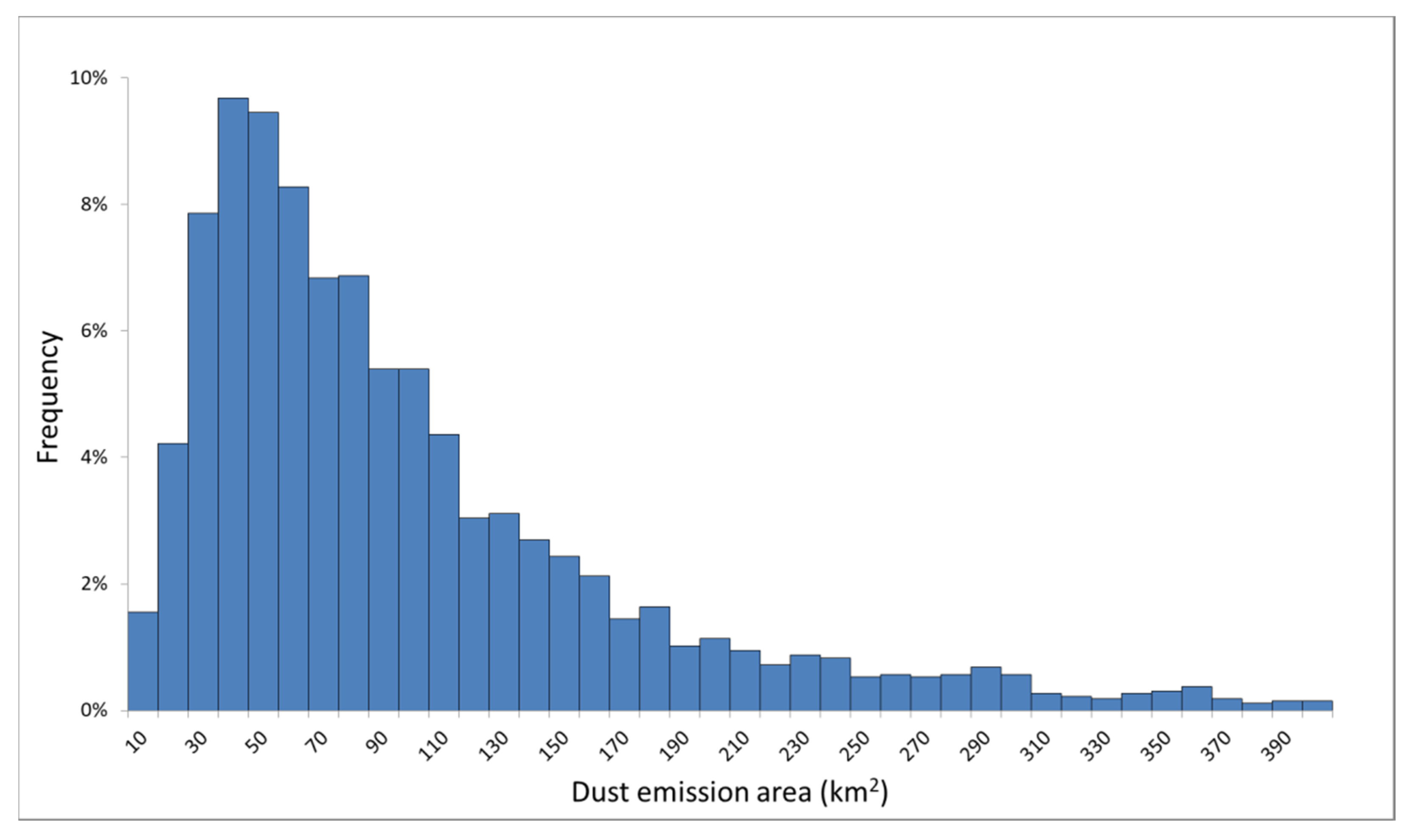
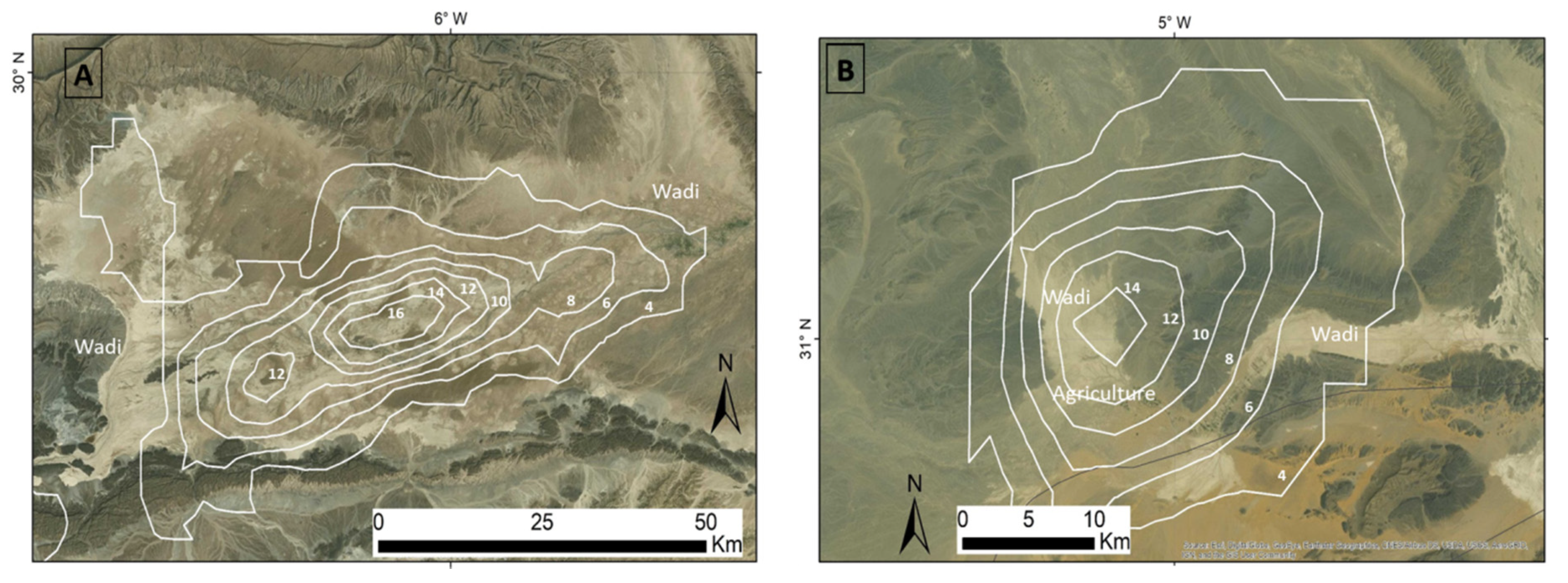
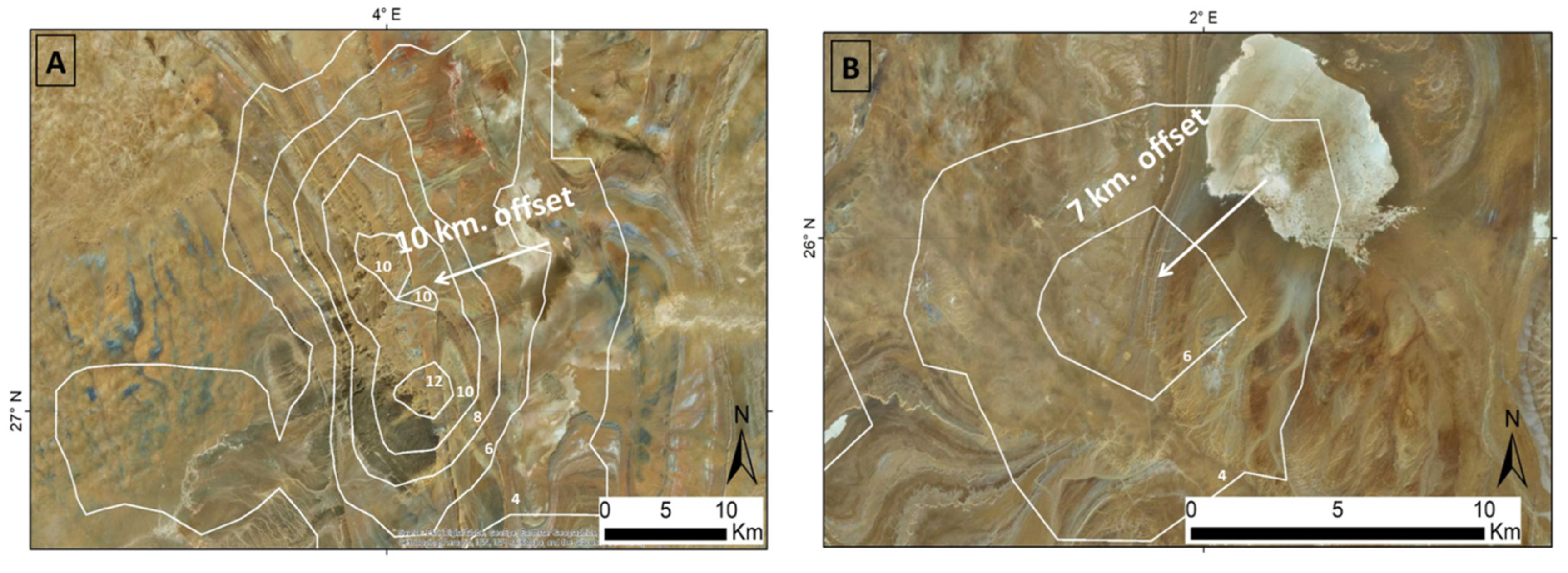
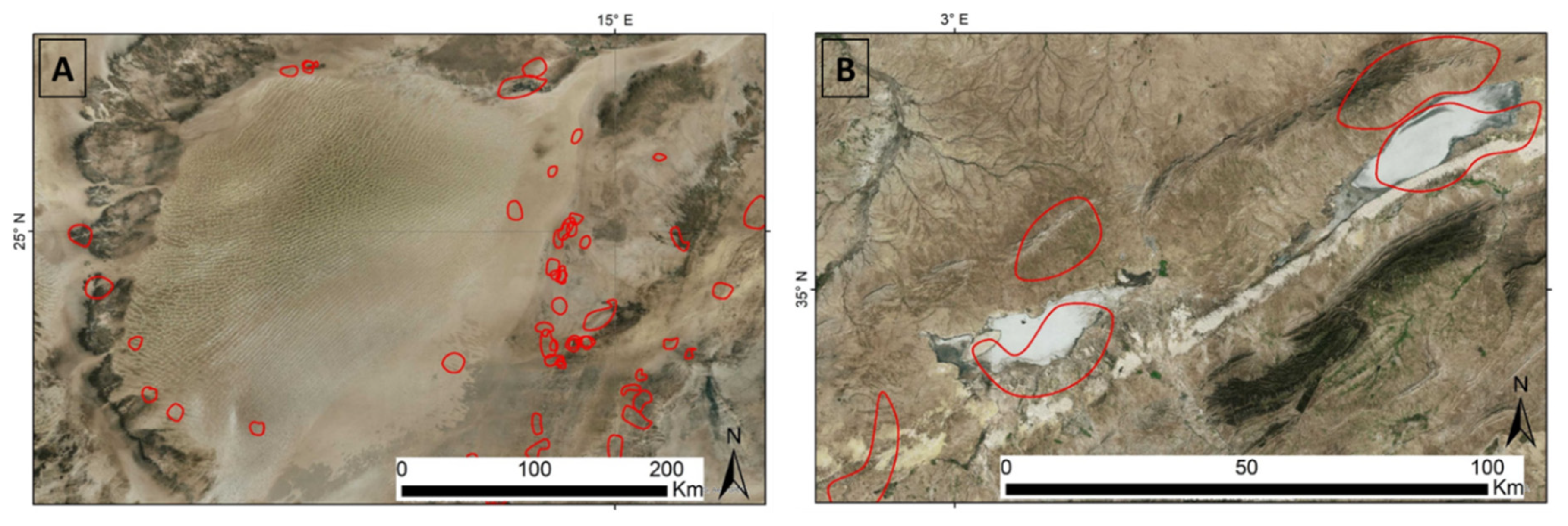
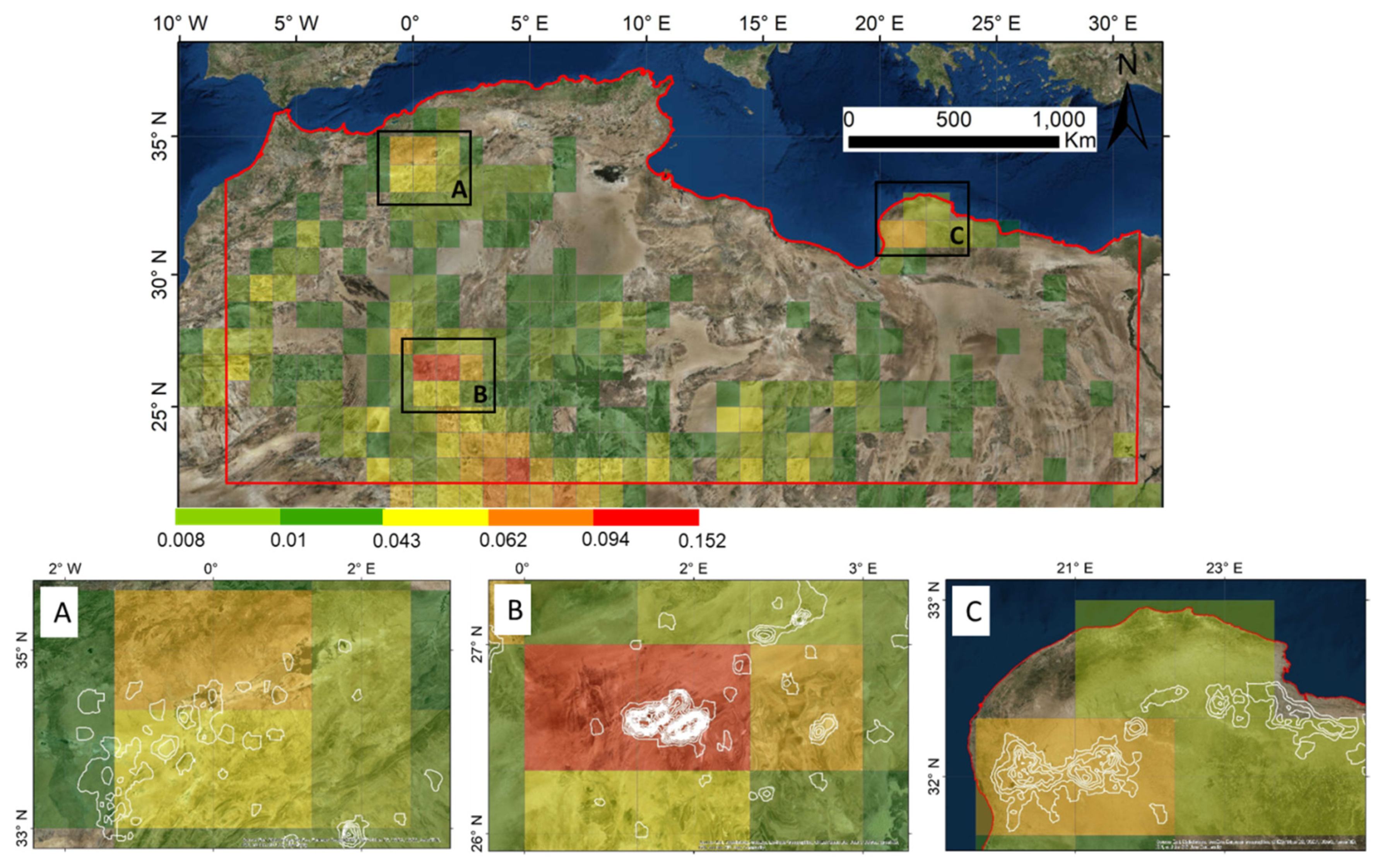
| Geomorphic Unit | Fluvial | Playa | Sand Dunes | Anthropogenic | Sum |
|---|---|---|---|---|---|
| Number [Percentage] | |||||
| Number of Dust Emitting Regions | 72 [40.4] | 62 [34.8] | 24 [13.5] | 20 [11.2] | 178 [100] |
| Number of Dust Events | 342 [33.2] | 449 [43.6] | 100 [9.7] | 138 [13.4] | 1029 [100] |
| Geomorphic Unit | LSM | LSM-HWSD | ||
|---|---|---|---|---|
| km2 | % | km2 | % | |
| Sand deposit | 106,345 | 35.2 | 89,966 | 29.8 |
| Sand deposit, on bedrock | 90,570 | 30.0 | 76,487 | 25.3 |
| Stony surface | 50,119 | 16.6 | 38,553 | 12.8 |
| Sand deposit, stabilized | 17,482 | 5.8 | 14,110 | 4.7 |
| Playa/Sabkha | 13,407 | 4.4 | 36,907 | 12.2 |
| Bedrock, with sediment | 12,009 | 4.0 | 10,140 | 3.4 |
| Bedrock | 6026 | 2.0 | 5639 | 1.9 |
| Fluvial system | 6012 | 2.0 | 30,192 | 10.0 |
| Anthropogenic | 146 | 0.0 | 139 | 0.0 |
| Water body/Wetland | 55 | 0.0 | 41 | 0.0 |
| Total | 302,171 | 100.0 | 302,175 | 100.0 |
| HWSD | ||
|---|---|---|
| Soil Unit | km2 | % |
| Calcisols (CL) | 155,714 | 52.0 |
| Leptosols (LP) | 42,744 | 14.3 |
| Rock debris (RK) | 26,651 | 8.9 |
| Playa units | 25,567 | 8.5 |
| Fluvisols (FL) | 24,678 | 8.2 |
| Sand dunes (DS) | 20,084 | 6.7 |
| Arenosols (AR) | 4082 | 1.4 |
| Regosols (RG) | 92 | 0.0 |
| Cambisols (CM) | 26 | 0.0 |
| Total | 299,639 | 100.0 |
© 2020 by the authors. Licensee MDPI, Basel, Switzerland. This article is an open access article distributed under the terms and conditions of the Creative Commons Attribution (CC BY) license (http://creativecommons.org/licenses/by/4.0/).
Share and Cite
Lavi Bekin, O.; Crouvi, O.; Blumberg, D.G. Areal Extent of Dust Emission Events and Source Geomorphology in Northern Africa from MSG-SEVIRI Data. Remote Sens. 2020, 12, 2775. https://doi.org/10.3390/rs12172775
Lavi Bekin O, Crouvi O, Blumberg DG. Areal Extent of Dust Emission Events and Source Geomorphology in Northern Africa from MSG-SEVIRI Data. Remote Sensing. 2020; 12(17):2775. https://doi.org/10.3390/rs12172775
Chicago/Turabian StyleLavi Bekin, Ofer, Onn Crouvi, and Dan G. Blumberg. 2020. "Areal Extent of Dust Emission Events and Source Geomorphology in Northern Africa from MSG-SEVIRI Data" Remote Sensing 12, no. 17: 2775. https://doi.org/10.3390/rs12172775
APA StyleLavi Bekin, O., Crouvi, O., & Blumberg, D. G. (2020). Areal Extent of Dust Emission Events and Source Geomorphology in Northern Africa from MSG-SEVIRI Data. Remote Sensing, 12(17), 2775. https://doi.org/10.3390/rs12172775



